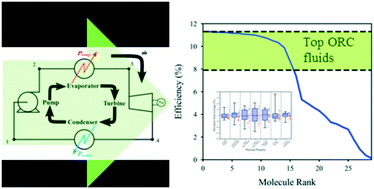当前位置:
X-MOL 学术
›
Mol. Syst. Des. Eng.
›
论文详情
Our official English website, www.x-mol.net, welcomes your
feedback! (Note: you will need to create a separate account there.)
Beyond a heuristic analysis: integration of process and working-fluid design for organic Rankine cycles
Molecular Systems Design & Engineering ( IF 3.2 ) Pub Date : 2019/12/09 , DOI: 10.1039/c9me00089e David H. Bowskill 1, 2, 3, 4, 5 , Uku Erik Tropp 1, 2, 3, 4, 5 , Smitha Gopinath 1, 2, 3, 4, 5 , George Jackson 1, 2, 3, 4, 5 , Amparo Galindo 1, 2, 3, 4, 5 , Claire S. Adjiman 1, 2, 3, 4, 5
Molecular Systems Design & Engineering ( IF 3.2 ) Pub Date : 2019/12/09 , DOI: 10.1039/c9me00089e David H. Bowskill 1, 2, 3, 4, 5 , Uku Erik Tropp 1, 2, 3, 4, 5 , Smitha Gopinath 1, 2, 3, 4, 5 , George Jackson 1, 2, 3, 4, 5 , Amparo Galindo 1, 2, 3, 4, 5 , Claire S. Adjiman 1, 2, 3, 4, 5
Affiliation

|
Industrial activity produces an enormous amount of waste heat energy in the form of low-temperature sources, the utilisation of which remains challenging due to low efficiencies and poor economic viability. Organic Rankine cycles (ORCs) offer an appealing solution to this challenge because the ORC efficiency can be drastically increased by tailoring the organic working fluid to the heat source. Due to the large number of potential fluids available, however, it is difficult to identify those fluids that give the highest ORC performance. Here we present a robust computer-aided molecular and process design technique for the determination of pure-component working fluids based on ORC performance metrics. In particular, factors that lead to process infeasibility are recognised, thereby enabling a diverse exploration of the working fluid design space while reducing the computational cost of the method. These algorithmic developments, in combination with the use of the predictive SAFT-γ Mie group-contribution methodology, provide a reliable platform for designing a wide range of ORCs. Excellent capability for determining optimal ORC designs from a vast number (58 960) of prospective fluids is demonstrated through three case studies. The optimal fluids identified include low molecular weight alkanes, alkenes, and ethers, such as propane, pent-1,4-diene and methyl ethyl ether. Importantly, we find that the performance of these fluids is not always transferable across applications. An analysis of fluid properties further highlights the limitations of using a heuristic approach for fluid selection. Instead, a holistic consideration of the working fluid in the cycle can lead to increased ORC performance.
中文翻译:

超越启发式分析:有机朗肯循环的过程和工作流体设计的集成
工业活动以低温源的形式产生大量的废热能,由于效率低和经济可行性差,其利用仍然具有挑战性。有机朗肯循环(ORC)提供了一个有吸引力的解决方案,因为可以通过将有机工作流体调整为热源来大大提高ORC效率。但是,由于可用的潜在流体数量众多,因此很难识别出具有最高ORC性能的流体。在这里,我们介绍了一种基于ORC性能指标的用于确定纯组分工作流体的可靠的计算机辅助分子和工艺设计技术。特别是可以识别导致流程不可行的因素,因此,可以在减少该方法的计算成本的同时,对工作流体设计空间进行多样化的探索。这些算法的发展,结合使用预测性SAFT-γMie基团贡献方法,为设计各种ORC提供了可靠的平台。通过三个案例研究,证明了从大量(58 960)种预期流体中确定最佳ORC设计的出色能力。确定的最佳流体包括低分子量烷烃,烯烃和醚,例如丙烷,-1,4-戊二烯和甲基乙基醚。重要的是,我们发现这些流体的性能并不总是可以在整个应用程序之间转移。流体特性的分析进一步突出了使用启发式方法进行流体选择的局限性。反而,
更新日期:2020-02-24
中文翻译:

超越启发式分析:有机朗肯循环的过程和工作流体设计的集成
工业活动以低温源的形式产生大量的废热能,由于效率低和经济可行性差,其利用仍然具有挑战性。有机朗肯循环(ORC)提供了一个有吸引力的解决方案,因为可以通过将有机工作流体调整为热源来大大提高ORC效率。但是,由于可用的潜在流体数量众多,因此很难识别出具有最高ORC性能的流体。在这里,我们介绍了一种基于ORC性能指标的用于确定纯组分工作流体的可靠的计算机辅助分子和工艺设计技术。特别是可以识别导致流程不可行的因素,因此,可以在减少该方法的计算成本的同时,对工作流体设计空间进行多样化的探索。这些算法的发展,结合使用预测性SAFT-γMie基团贡献方法,为设计各种ORC提供了可靠的平台。通过三个案例研究,证明了从大量(58 960)种预期流体中确定最佳ORC设计的出色能力。确定的最佳流体包括低分子量烷烃,烯烃和醚,例如丙烷,-1,4-戊二烯和甲基乙基醚。重要的是,我们发现这些流体的性能并不总是可以在整个应用程序之间转移。流体特性的分析进一步突出了使用启发式方法进行流体选择的局限性。反而,











































 京公网安备 11010802027423号
京公网安备 11010802027423号